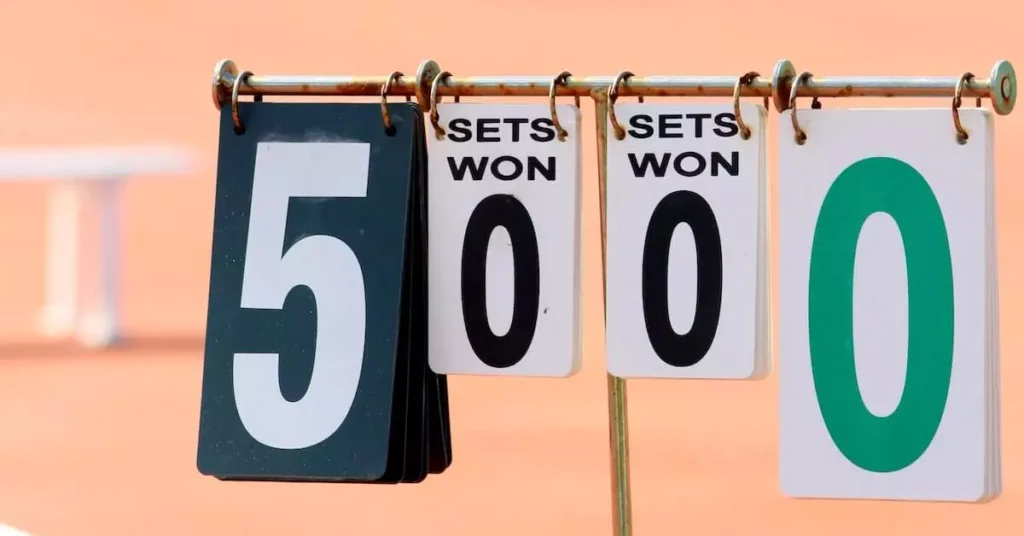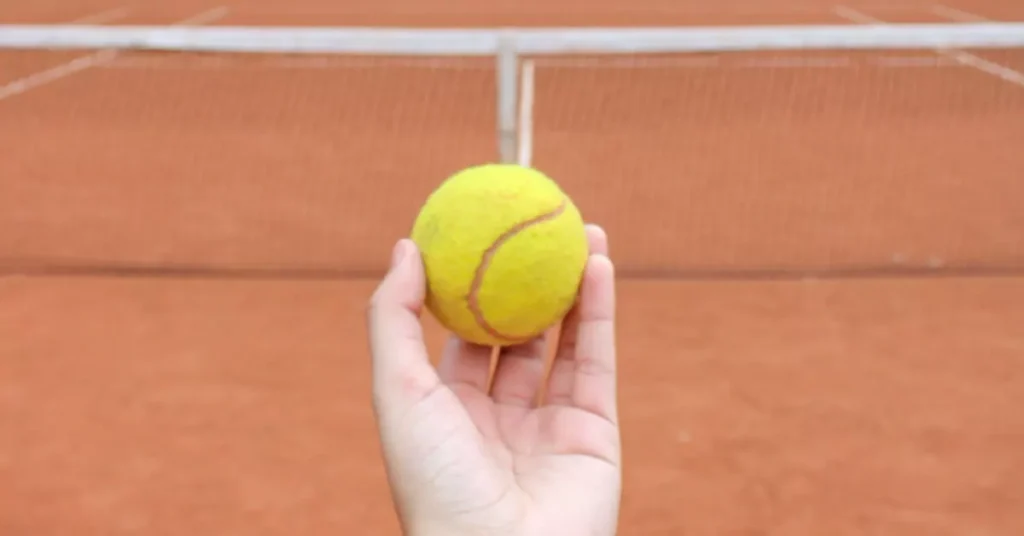Are you a beginner when it comes to tennis? Do you find yourself confused by the scoring system? Fear not, because this article will break down the basics of tennis scoring for dummies. Tennis scoring may seem complicated at first, but once you understand the rules, it’s actually quite simple.
Here’s a quick summary of the tennis scoring point system:
| Points | Score |
|---|---|
| 0 | Love |
| 1 | 15 |
| 2 | 30 |
| 3 | 40 |
| Tied | All |
| 40-40 | Deuce |
| Ad-in | Server wins deuce point |
| Ad-out | Receiver wins deuce point |
Remember, the first player to win six games (with a two-game lead) wins the set, and the first player to win two or three sets (depending on the tournament) wins the match.
Tennis Scoring for Dummies: How Does Tennis Scoring Work?
The tennis scoring system can seem confusing at first. But don’t worry, it’s actually quite simple once you understand the basics. In this section, I’ll explain how tennis scoring works and break it down into three sub-sections: Scoring a Game, Scoring a Set, and Scoring the Match.
Scoring a Game
Each tennis game starts with a score of “love” (0-0). The first point a player wins is 15, the second point is 30, the third point is 40, and the fourth point wins the game. If both players are tied at 40, it’s called “deuce.” From there, the next player to win a point gets “advantage.” If that player wins the next point, they win the game. If the other player wins the next point, it goes back to deuce.
Scoring a Set
A set is a collection of games. The first player to win six games wins the set. However, there’s a catch. If both players are tied at five games each, they must play until one player wins by two games. For example, if the score is tied at 6-6, they’ll play until someone wins 8-6 or 9-7.
Scoring the Match
A tennis match is typically played as a best-of-three or best-of-five sets. To win the match, a player must win the majority of the sets. So, if it’s a best-of-three match, the first player to win two sets wins the match. If it’s a best-of-five match, the first player to win three sets wins the match.
That’s it! Now that you understand the basics of tennis scoring, you’ll be able to follow along with any tennis match.
Tennis Scoring for Dummies: Tennis Scoring Terms and Their Meanings

If you’re new to tennis, understanding the scoring system can be a bit confusing. Here are some commonly used tennis scoring terms and their meanings to help you get started:
- Deuce: When both players have won three points each, the score is tied at 40-40, which is called deuce. To win a game from deuce, a player must win two consecutive points. The first point won after deuce is called “advantage” for that player.
- Advantage: If a player wins a point after deuce, they gain the advantage. If they win the next point as well, they win the game. If the other player wins the next point, the score goes back to deuce.
- Ad-In and Ad-Out: When a player has the advantage, the score is referred to as “ad-in” or “ad-out” depending on which player has the advantage. “Ad-in” means the server has the advantage, while “ad-out” means the receiver has the advantage.
- Let: If the ball touches the net but still lands in the correct service box, it is called a “let.” The player gets to serve again without penalty.
- Ace: When a player serves the ball and the receiver is unable to return it, it is called an “ace.” This results in an automatic point for the server.
- Double Fault: If a player fails to get their serve in play twice in a row, it is called a “double fault.” This results in an automatic point for the receiver.
- Faults: If a player’s serve lands outside the correct service box or fails to clear the net, it is called a “fault.” The player gets a second serve, but if they fault again, it results in a point for the receiver.
- Tiebreak: In some tournaments, if the score is tied at 6-6 in a set, a tiebreak is played. The first player to reach seven points with a two-point lead wins the tiebreak and the set.
- Advantage Set: In some tournaments, instead of playing a tiebreak in the final set, players continue to play until one player has a two-game lead. This is called an “advantage set.”
Tennis Scoring for Dummies: Tennis Score After a Deuce
After the score reaches 40-40, also known as deuce, the next point is critical. The player who wins the next point will have the advantage. The term advantage in tennis scoring means that the player needs to win the next point to win the game. If the player with the advantage wins the next point, they win the game. If the other player wins the next point, the score goes back to deuce.
There are two types of advantages in tennis: Ad-In and Ad-Out. If the server wins the next point after deuce, the score becomes Ad-In. If the receiver wins the next point after deuce, the score becomes Ad-Out.
If the player with the advantage wins the next point, they win the game. If the other player wins the next point, the score goes back to deuce. This process continues until one player wins the game by two points.
It is important to note that if a player serves a let, which means the ball touches the net and still lands in the service box, then the serve is retaken without any penalty. However, if the player serves a fault, then the point goes to the other player.
Moreover, if a player hits a shot that the opponent cannot return, it is called an ace. On the other hand, if the player hits the ball out of bounds or into the net on their serve, it is called a double fault, and the point goes to the other player.
In some cases, a tiebreaker is played when the score is tied at six games each in a set. In a tiebreaker, the first player to reach seven points with a margin of two points wins the tiebreaker and the set. In an advantage set, the player must win by two games to win the set.
Tennis Scoring for Dummies: Tennis Scoring in Doubles

Tennis scoring in doubles is similar to that in singles, but with a few differences. In doubles, there are two players on each team, and the court is wider than in singles. Here are the basic rules of tennis scoring in doubles:
Scoring
- Points are the same as in singles: 15, 30, 40, and game.
- If the score is tied at 40-40, it’s called “deuce.”
- The next point wins the game, but a player must win by two points.
- If a team wins six games and is ahead by at least two games, they win the set.
- If the score is tied at six games each, a tiebreaker is played to determine the winner of the set.
Serving
- Each player serves for one game at a time.
- The server must serve from the right side of the court to the opponent’s right service box.
- The serve must clear the net and land in the correct service box.
- If the serve hits the net and lands in the correct service box, it’s called a “let” and the server gets to serve again.
- If the serve hits the net and lands outside the correct service box, it’s called a fault.
Doubles Strategies
- Communication is key in doubles. Players should communicate with each other before and during each point to avoid confusion and maximize their chances of winning.
- Players should try to cover the court as much as possible, with one player at the net and one player at the baseline.
- When returning serve, players should aim for the opponent’s weaker side and try to hit the ball down the middle to create confusion.
In a doubles match, the tennis scoring system is the same as in a singles match. The first team to win two sets wins the match in a best-of-three sets match, and the first team to win three sets wins the match in a best-of-five sets match.
Tennis Scoring for Dummies: Types of Tennis Sets

When it comes to tennis sets, there are a few different types of sets you might encounter. In this section, we’ll dive into the different types of sets you might come across in a tennis match.
Advantage Set vs Tiebreak Set
An advantage set is a set where you need to win by two games. This means that if the score is tied at 6-6, you’ll keep playing until someone wins by two games. This type of set is less common these days, but you might still see it in some tournaments.
A tiebreak set is a set where you play a tiebreak game if the score is tied at 6-6. The winner of the tiebreak game wins the set. This type of set is more common these days, and it makes for more exciting matches.
Scoring a Tiebreak Game
A tiebreak game is a game played to decide a set that is tied at 6-6. In a tiebreak game, the first player to win seven points wins the game. However, you need to win by two points. If the score is tied at 6-6, you’ll keep playing until someone wins by two points.
Serving After a Tiebreak Set
After a tiebreak set, the player who served first in the tiebreak game will receive serve in the next set. This means that if you served first in the tiebreak game and you won the set, you’ll receive serve in the next set. If you lost the tiebreak game, you’ll serve first in the next set.
10-Point Tiebreak
A 10-point tiebreak is a tiebreak game played in place of a third set. This type of tiebreak is used in some tournaments to speed up the match. In a 10-point tiebreak, the first player to win ten points wins the game. However, you still need to win by two points.
8-Game Pro-Set
An 8-game pro-set is a shortened set that is played to eight games instead of the usual 12 or more games. This type of set is often used in doubles matches or in lower-level tournaments. The first player or team to win eight games wins the set.
4-Game Set
A 4-game set is another shortened set that is played to four games instead of the usual 6 or more games. This type of set is often used in junior matches or in beginner-level tournaments. The first player or team to win four games wins the set.
Tennis Scoring for Dummies: Starting a Tennis Match

Starting a tennis match is a simple process that involves a coin toss to determine who serves first. The winner of the coin toss can either choose to serve or receive, while the loser gets to pick which side of the court they want to start on. Before you start a game, make sure you have familiarized yourself with the Tennis Etiquette, which I explain in this article.
Once the decision has been made, the server will stand behind the baseline on one side of the court and serve the ball to the receiver on the other side of the court. The receiver must then return the serve, and the point begins.
It’s important to note that the server must serve from behind the baseline, and they only get two attempts to get the serve in. If they fail to get the serve in on both attempts, it’s called a “double fault,” and they lose the point.
If the server wins the point, they get to serve again from the same side of the court. If the receiver wins the point, they become the server and serve from the opposite side of the court.
Tennis Scoring for Dummies: Switching Ends
Switching ends is an important aspect of tennis scoring that occurs after every odd-numbered game. It is done to ensure that neither player has an advantage due to the sun, wind, or any other environmental factors.
When switching ends, players change sides of the court and take a short break to rest and rehydrate. This break can last up to 90 seconds, but players are encouraged to keep it brief to maintain the flow of the game.
It’s important to note that switching ends also occurs during tiebreaker games. After the tiebreaker game, players switch sides of the court, and the player who started serving the tiebreaker game receives serve in the first game of the next set.
During the break, players can use the time to strategize, discuss with their coaches, or just catch their breath. However, they must be ready to resume play as soon as the break is over.
In doubles matches, players switch ends with their partners, and the receiving team chooses which player will receive serve in the next game. This ensures that neither team has an unfair advantage due to the court or other environmental factors.
Tennis Scoring for Dummies: Scoring in the Grand Slam Matches

If you are a fan of professional tennis, you must have heard of the Grand Slam tournaments. These are the four most prestigious events in the tennis calendar year: Australian Open, French Open, Wimbledon, and US Open. The tennis scoring system in Grand Slam matches is the same as in any other tennis match, but there are a few differences you should be aware of.
Sets and Games
In Grand Slam matches, the players compete in a best-of-five sets format for men and a best-of-three sets format for women. To win a set, a player must win six games by a margin of two games. If the score is tied at six games each, a tiebreaker game is played to determine the winner of the set. The tiebreaker game is played up to seven points, and the player who wins by a margin of two points wins the set.
Points
In each game, the players earn points by winning rallies. The tennis scoring system is a bit different from other sports. Instead of counting points by one, the first point is worth 15, the second point is worth 30, the third point is worth 40, and the fourth point is the game-winning point. If both players win three points each, the score is tied at 40, which is called “deuce.” From there, the player who wins the next point earns “advantage,” and if they win the following point, they win the game.
Tiebreakers
In Grand Slam matches, tiebreakers are played if the score is tied at six games each in a set. Tiebreakers are played to seven points, and the player who wins by a margin of two points wins the tiebreaker. The player who serves first in the tiebreaker game serves one point, and then the players alternate serving two points each until the tiebreaker game is over.
Tennis Scoring for Dummies: Tennis Scoring History
Tennis has a long and interesting history, and so does its scoring system. The origins of the tennis scoring system can be traced back to the game of jeu de paume, which was played in France in the 12th century. The game was played with a ball and a hand, and the scoring system was based on the number of points won by a player.

Over time, the game evolved, and players began to use rackets instead of their hands. The scoring system also changed, and the current tennis scoring system was born.
The current tennis scoring system is based on a game of four points. The first point is called “15,” the second point is called “30,” the third point is called “40,” and the fourth point is called “game.” If both players are tied at 40 points, it is called “deuce.” To win the game, a player must score two consecutive points after deuce.
The origins of the terms “15,” “30,” and “40” are not entirely clear. Some historians believe that they are based on the clock face, where the hand moved from the 15-minute mark to the 30-minute mark and then to the 45-minute mark, which was later changed to “40” for simplicity. Others believe that the terms are based on the French words for “quarter,” “half,” and “three-quarters,” which were used to describe the points won by a player.
FAQ
How do you score tennis?
Tennis scoring can be a bit confusing for beginners, but it’s actually quite simple once you understand the basics. In tennis, each point is worth one point, and the first player to win four points wins the game. However, the tennis scoring system is a bit different than most sports. Instead of using the numbers 1-4, tennis uses a unique scoring system where the points are called 15, 30, 40, and game. When a player wins their first point, they say “15.” If they win the next point, they say “30.” If they win the third point, they say “40.” If both players are tied at 40, it’s called “deuce.” From there, the first player to win two consecutive points wins the game.
How many sets need to be won in tennis?
To win a tennis match, a player must win the majority of sets. In most professional matches, players must win three out of five sets to win the match. However, in some tournaments, players only need to win two out of three sets to win the match. In each set, the first player to win six games wins the set. If both players are tied at six games each, a tiebreaker is played to determine the winner of the set.
Why is 15 30 40 in tennis?
The origin of the 15-30-40 scoring system in tennis is not entirely clear. Some historians believe that it may have originated from a clock face, where the quarter-hour was called “15,” the half-hour was called “30,” and the three-quarter hour was called “45.” Over time, “45” was shortened to “40” to make scoring easier. Others believe that the tennis scoring system may have been derived from an old French game called “Jeu de Paume,” which used a similar scoring system.
Why do they say love for 0 in tennis?
The term “love” is used in tennis to represent a score of zero. The origin of the term is not entirely clear, but some historians believe that it may have come from the French word “l’oeuf,” which means egg. The shape of an egg is similar to the number zero, and the French word for egg sounds similar to the word “love.” Over time, “l’oeuf” may have been shortened to “love” to make scoring easier.
Tennis scoring after deuce?
After deuce, the first player to win two consecutive points wins the game. When a player wins their first point after deuce, they say “advantage in” or “ad in.” If they win the next point, they win the game. However, if the other player wins the next point, the score goes back to deuce. This process continues until one player wins two consecutive points and wins the game.
We’re curious about your thoughts on tennis scoring. Do you find it confusing or straightforward? Share your insights and experiences in the comments below.






